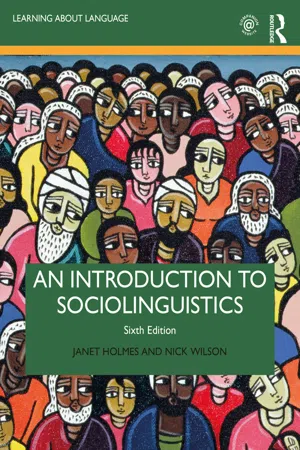
- 710 pages
- English
- ePUB (mobile friendly)
- Available on iOS & Android
An Introduction to Sociolinguistics
About this book
Sociolinguistics is the study of the interaction between language and society. In this classic introductory work, Janet Holmes and Nick Wilson examine the role of language in a variety of social contexts, considering both how language works and how it can be used to signal and interpret various aspects of social identity. Divided into three parts, this book explains basic sociolinguistic concepts in the light of classic approaches, as well as introducing more recent research.
This sixth edition has been revised and updated throughout, using key concepts and examples to guide the reader through this fascinating area, including:
• New material on gender, social media and online use of language, codeswitching, and language policy
• An updated companion website that is fully cross- referenced within this book and features video and audio materials and links to useful websites
• Revised examples and exercises that include new material from Asia and South America
• Fully updated further reading and references sections
An Introduction to Sociolinguistics is an essential introductory text for all students of sociolinguistics and a splendid point of reference for students of English language studies, linguistics, and applied linguistics.
Frequently asked questions
- Essential is ideal for learners and professionals who enjoy exploring a wide range of subjects. Access the Essential Library with 800,000+ trusted titles and best-sellers across business, personal growth, and the humanities. Includes unlimited reading time and Standard Read Aloud voice.
- Complete: Perfect for advanced learners and researchers needing full, unrestricted access. Unlock 1.4M+ books across hundreds of subjects, including academic and specialized titles. The Complete Plan also includes advanced features like Premium Read Aloud and Research Assistant.
Please note we cannot support devices running on iOS 13 and Android 7 or earlier. Learn more about using the app.
Information
1What do sociolinguists study?
What is a sociolinguist?
| Ray: | Hi mum. |
| Mum: | Hi. You’re late. |
| Ray: | Yeah, that bastard Sootbucket kept us in again. |
| Mum: | Nana’s here. |
| Ray: | Oh sorry. Where is she? |
| Ray: | Good afternoon, sir. |
| Principal: | What are you doing here at this time? |
| Ray: | Mr Sutton kept us in, sir. |
- Identify the words in examples 1 and 2 which suggest that Ray’s relationship with his mother is a friendly one compared to his relationship with the principal. What does this suggest about the social significance of choice of words?
- Ray greeted the principal with the words Good afternoon, sir. How do or did you greet your school principal? Would you use the same words to your father or mother? Would you use the same greeting to your best friend? Why (not)?
- Nicknames can express affection as well as dislike. What clues indicate that Ray is not feeling affectionate towards his teacher?
Why do we say the same thing in different ways?
- addressing her
- at home alone with her
- on the telephone with friends listening
- in a shop
- referring to her
- at home to another family member when she is present
- at home to another family member when she isn’t present
- to an acquaintance who doesn’t know her
- to a sales assistant in a shop when she is present.
What are the different ways we say things?
| Sam: | You seen our ’enry’s new ’ouse yet? It’s in ’alton you know. |
| Jim: | I have indeed. I could hardly miss it Sam. Your Henry now owns the biggest house in Halton. |
Table of contents
- Cover
- Half-Title Page
- Series Page
- Title Page
- Copyright Page
- Dedication Page
- Contents
- List of figures
- List of maps
- List of tables
- Preface to sixth edition
- Preface to fifth edition
- Preface to fourth edition
- Preface to third edition
- Preface to second edition
- Preface to first edition
- Authors’ acknowledgements
- The online companion
- 1 What do sociolinguists study?
- Part I Multilingual speech communities
- Part II Language variation: focus on users
- Part III Language variation: focus on uses
- References
- Appendix: phonetic symbols
- Sociolinguistics: key words and concepts
- Index